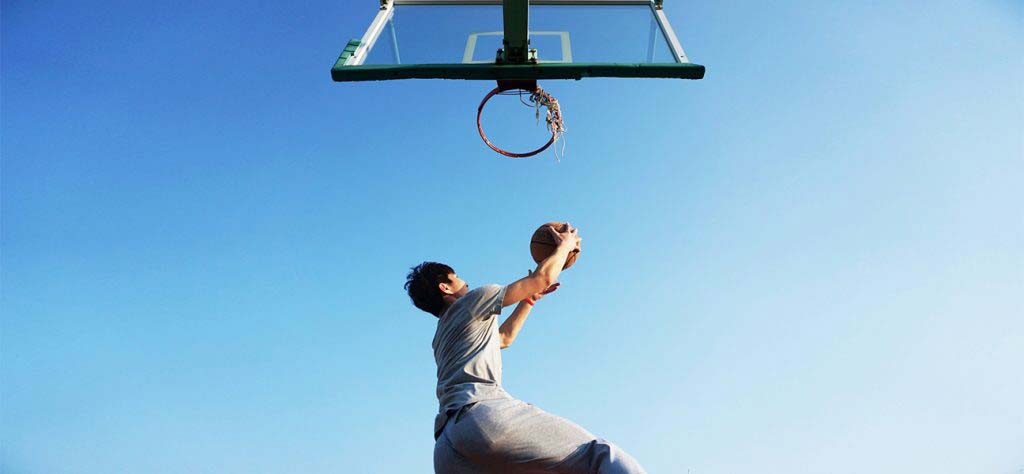
Greg Maddux, former pitcher for the Atlanta Braves, Chicago Cubs, and Los Angeles Dodgers, had LASIK done in 1999. He described LASIK as “the best thing I ever bought myself.” What he got for himself was 20/15 eyesight. Two days after the procedure, Maddux was on the baseball field, pitching a one-hitter despite having only had 0-3 six starts during the entire season.
Former Dallas Cowboys quarterback, Troy Aikman, underwent LASIK vision correction in 1998. Before the surgery, his eyesight was 20/600. “I couldn’t even read the big ‘E’ on the eye chart,” he says. After LASIK, Aikman’s vision was 20/20.
LeBron James, a basketball player for the Cleveland Cavaliers, had LASIK surgery in 2007. Afterward, he told reporters he could see the basketball rim and net “clearer than ever.” The athlete’s claims matched up with his field goal percentage, which went from 46 to 49 percent after LASIK.
Tiger Woods had LASIK in 1999. Before the procedure, he was considered “legally blind” without his glasses, and couldn’t even see the other side of the room. “As a professional golfer, my eyesight was just too important to risk,” Woods told reporters. After LASIK, his vision improved to 20/15. His game improved too. Before the procedure, his average score was 4 under. Following LASIK, the number improved to 10 under par.
These are just some names on the long list of famous sports stars who have solved their vision problems and improved their games with LASIK surgery. But you don’t have to be a professional athlete to benefit from LASIK.
LASIK can be a beneficial procedure for people of all walks of life. The biggest benefit is a better vision. The vast majority of patients achieve 20/20 vision or better, and results are normally permanent. Not only that, life becomes so much easier. You no longer have to deal with the inconvenience of wearing glasses or contacts. LASIK also saves you a lot of money in the long run as you don’t have to always be buying new prescription glasses, contact lenses or sunglasses.
LASIK offers some particular benefits for athletes—amateurs and professionals alike. LASIK can actually make it much more doable to play certain sports, which may be off-limits to people who wear glasses. It’s hardly practical to wear glasses on the basketball court, tennis court, or football field. Glasses can easily get lost or broken during a game. If you’re outside on a hot, humid day, they can fog up and get smudged. If your eyeglasses crack or break while you’re wearing them, they can cut or injure your eyes.
Contacts, too, can be a problem. They can get irritated by sweat and dirt, especially if you are wearing them while outdoors. If you’re playing a game in a dirty or dusty environment, or if it’s very windy, your eyes can start feeling sandy, dry or gritty. The other issue with contacts is they can shift (or even fall out and disappear) in the midst of sports activities. That’s a possibility if you’re running or moving around on the ground, but also if you’re swimming in the water. LASIK can eliminate all of these problems.
In addition, LASIK can actually improve your sports performance, just as it did for the professional athletes mentioned above because your vision is drastically improved. The fact is, athletes need a good vision if they are going to excel in their sports. They need to be able to rely on their hand and eye coordination in order to succeed. When you can clearly see your teammate who is 50 yards down the field, you’ll do a much better job of throwing the football to him.
One misconception that needs to addressed is the false assumption that LASIK requires weeks of downtime for recovery, which may impede with an athlete’s practice and game schedules. This is a myth; you can resume the majority of your athletic activities the day after your LASIK surgery.
It’s important to note, however, that athletes are at a higher risk of complications due to their increased risk of injury, particularly in contact sports such as football or martial arts. The main concern during LASIK recovery is damage to the corneal flap before it fully heals, causing it to reopen. Should this happen, it will need to be set back into place by your doctor before it becomes infected. This is something that is normally easily remedied, without any complications.
Whether you aim to be a professional athlete or just want to maintain an active lifestyle, the results of LASIK can be truly life-changing. Visual accuracy is vital in all of our day-to-day activities, not just for athletes, but for everyone. That is exactly why more and more people are choosing LASIK.
Eye Safety Issues and Tips for Athletes
Another big vision-related issue for athletes is how to protect their eyes when playing sports. According to the American Academy of Ophthalmology, more than 40,000 eye injuries occur each year from sports that are severe enough to require a trip to the emergency room. Often it’s during a basketball, baseball, football, hockey, or racquetball game. But those aren’t the only potentially dangerous sports. People can also injure their eyes while playing tennis, volleyball, lacrosse, badminton, handball soccer, or golf—really any activity that involves flying or fast-moving objects.
The faster the object’s speed, the greater the potential danger. For instance, with racquetball, the ball can whizz by at 60 to 200 miles per hour, and if the ball hits the eyes, it can cause permanent damage. The same is true with a baseball traveling at 60, 80, or 100 m.p.h.
Flying objects aren’t the only concern. With some sports, such as basketball, a player’s eye might get poked or jabbed by another player’s fingers, fist, elbows or foot. During a baseball game, debris can blow into a player’s eyes as he slides into home plate. A direct blow to the eye—a real probability when playing football or boxing—can damage the eyeball, supporting muscles, blood vessels or nerves, or fracture the bones around the eye.
A lot of times eye injuries from sports are minor—such as black eyes, eyelid lacerations and mild scrapes of the cornea. These conditions may cause some pain, but they won’t do any lasting damage. Other eye injuries, such as orbital bone fractures, retinal detachments, retinal swelling, optic nerve avulsion (tearing away), and optic neuropathies (damage to the optic nerve) are much more serious and can cause visual impairment or even blindness.
Even if there appears to be no injury immediately after a sports accident, damage may still have occurred, but just not become noticeable until considerable time has passed. For example, severe blunt trauma to the eye may lead to small tears in the retina or cause glaucoma. These conditions may not manifest themselves until many years after the initial injury. Unfortunately, by the time the patient notices changes in his vision, it may be too late to treat.
One recent study found that 66 to 76 percent of boxers had sustained some level of ocular trauma while being completely asymptomatic. The trouble is, without noticing any symptoms, the temptation may be to assume everything is fine. If the condition is not addressed, it can lead to the development of glaucoma and blindness.
It doesn’t have to be just one single, large blow that causes vision loss. Repeat trauma to the eyes, consisting of recurring mild or moderate blows over time, can eventually lead to permanent damage. An example of this would be what happened to world welterweight boxing champion, Sugar Ray Leonard, who sustained multiple retinal detachments after many years of sustained blows to the eyes.
All this is not said to discourage you or your children from being involved in sports. Playing sports can be a wonderful pastime, help relieve stress and pressure, and improve your overall fitness goals. But you do need to take precautions to protect your eyes and your vision.
The good news is that the vast majority of eye injuries can be prevented by taking some relatively simple measures. In fact, volunteer eye health and safety organization, Prevent Blindness America, estimates that 90 percent of sports-related eye injuries can be prevented. What follows are some steps we recommend athletes take, to protect their eyes and eyesight:
Use Protective Eyewear
The majority of eye injuries can be prevented by wearing goggles or wraparound frames with polycarbonate lenses (which are designed to withstand impact). Don’t try to get by with simply wearing your normal eyeglasses, as they will not provide enough protection and could even break and damage your eyes. Ideally, the protective eyewear you select should be labeled as being ASTM F803 approved, signifying that it is performance tested and provides the highest level of safety.
Put on a Helmet and Face Guard
When playing contact sports such as baseball, hockey and men’s lacrosse, wear a helmet with a face mask or eye shield. Both the helmet and face guard should be made of polycarbonate, which is a strong, shatterproof, lightweight plastic. Be sure the helmet fits properly. If it is too snug or too loose, it won’t protect you the way it’s supposed to.
Wear Soft Contact Lenses and Always Have a Backup
Wearing soft contact lenses while playing sports is generally safer than wearing eyeglasses, as this removes the risk of your glasses being broken and glass entering your eyes. Contacts also provide the peripheral vision necessary when playing team sports. It’s a good idea to bring a replacement contact lens with you to the game, just in case you get hit in the face with a fly ball or an opponent’s elbow, and lose a contact lens in the field.
Invest in Sport-specific Eyewear
Another idea if you need to wear eyeglasses during game time, is to purchase a pair that is designed for your specific sport, or for multi-sport use. Sport-specific eyewear is available for baseball, basketball, football, golf, skiing, cycling and other popular sports. These glasses have lightweight, flexible frames and shatterproof lenses made from polycarbonate. Ideally, you should wear an eyeglass cord or pick a pair of frames that wrap around your head to prevent them slipping or falling off your face.
See an Ophthalmologist Immediately After any Eye Injury
If the unexpected happens and your eye is injured during a game, a visit to the eye doctor is always recommended, even if you think the injury is minor. It’s important to have your eye(s) checked out to make sure the problem isn’t more serious, and to determine whether you sustained any “hidden” damage. If there is a problem that needs to be addressed, the sooner it is treated, the better. Procrastinating could lead to permanent eye injury or even blindness, depending on the severity of your injury.
Consider Undergoing LASIK
If you’ve tried playing sports while wearing glasses, you know how frustrating it can be trying to keep your glasses on when you’re dribbling the basketball or sprinting on the tennis court to return the ball. If you’re over age 18, LASIK surgery may be a good option for you. Not only will you no longer have the limitations of glasses and improve your overall vision, but LASIK may also increase your peripheral vision and boost hand-eye coordination.
LASIK also offers improvements to overwearing contact lenses. No longer will you have to worry about your contacts shifting while you’re in motion, or losing them completely. Contacts can also dry out your eyes, causing you to blink more frequently and miss some of the action in the game. Having LASIK done so you no longer have to wear contacts when you’re playing sports, may help to reduce dry eye symptoms.

Please Take Our LASIK or Cataract Surgery Quiz
Take our vision quiz to find out if you qualify for LASIK or cataract surgery!


